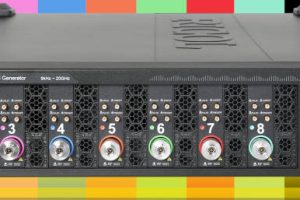
The MSO8000 digital oscilloscope has been added to the company’s UltraVision II range which is characterised by its Phoenix chipset architecture and with two asics developed in-house.
Bandwidths options are 600MHz, 1GHz and 2 GHz and maximum sampling rate is 10Gsps. Memory depth is 500MPts for all channels and signal acquisition rate is up to 600,000Wfms/s enabling real-time recording and playback of signals with up to 450,000 frames.
The speed of acquisition and analysis of signals makes it suitable for automated tests, protocol analysis for serial buses in automotive electronics, measurement of electronic circuits, measurements and analysis of switching power applications in R&D, universities, production and quality control in automotive, communications, aerospace industries and power electronics development. The scopes have a large capacitive 10.1-inch colour touchscreen and a new integrated measurement method including real-time eye diagram, jitter analysis software and display of the jitter trend.
The company offers all extensions, such as increased bandwidths, MSO-ready with 16 digital channels, serial decoding, memory expansion and the two-channel arbitrary generator functions via software upgrade.
The second DSO is the expanded MSO5000 oscilloscope series with a nine-inch colour touchscreen. Models have bandwidths from 70 to 350MHz (a bandwidth upgrade is possible) and a sampling rate of 8Gsps. Memory depth is up to 200m points and signal acquisition rate is up to 500,000Wfms/s which is designed for the user to acquire, display and evaluate fast signal sequences. The sensitive input of 500µV/div allows very small signal details to be analysed, says the company.
The BodePlot function has now been integrated in all MSO5000 series oscilloscopes.
Both the MSO8000 and MSO5000 models have been expanded with a 12-bit high resolution mode. Trigger, math and display options have been extended and the serial bus protocol analysis functions are now also available in an expanded form. The scopes also include an integrated voltmeter, frequency counter and an optional two-channel arbitrary function generator.
Visitors will also see the new RSA3000-E spectrum analyser series, with devices based on the company’s UltraReal technology. The analysers can be used as a “scalar” network analyser thanks to an additional 1.5/3.0 GHz tracking generator, says the company.
Four functions are available: real-time spectrum analyser (RTSA), up to 10MHz bandwidth; GPSA, spectrum analyser, an integrated test tool for EMI pre-conformity tests according to CISPR and VSA, ASK/FSK demodulation
The RT-SA module has real-time bandwidth of 10MHz. The speed of FFT calculation provides the instrument with a 100% probability of detection with correct amplitude (POI) of up to 9.3µs, says the company. In RTSA mode, signals can be recorded that cannot be measured with a normal spectrum analyser; measurements such as tightness via the frequency, spectrogram or the power over the time range can be displayed and all representations can be displayed at the same time. This is particularly useful for measurements for the IoT, connected homes or wireless communications. The frequency mask trigger (FMT) can be used to acquire signals that are difficult to determine.
The GP-SA module is characterised by low DANL (-161dBm/Hz, typical).
Integrated options, such as EMI filter and quasi peak kit, expandable measurement functions and the EMI tool in the RSA3000E-TG mean that it is suitable for pre-compliance testing of assemblies, devices and components. It can be used to run inexpensive pre-tests in-house before the products are given to external, certified and cost-intensive test laboratories. This ensures that the EU standards for EMC are already met during product development.
Embedded World 2020: Hall 4-528
 Electronics Weekly Electronics Design & Components Tech News
Electronics Weekly Electronics Design & Components Tech News




“The BodePlot function has now been integrated in all MSO5000 series oscilloscopes.” – is this correct?
I haven’t been able to find any reference to this on the Rigol website. Great news if it is true though!